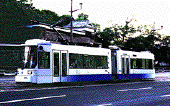 Science & Technology || Search|| Back Numbers BACK ON TRACK: Streetcars Return to Japan's Cities January 14, 1998 
Street cars should become a more common sight in the coming years. (Photo: Kumamoto City Transportation Bureau) They have zero emissions, and are easy to use for all members of society. With environmental and welfare issues in the spotlight as seldom before, Japan is reappraising and reviving the streetcar. And as lines are far cheaper to build than metros and other high-tech transit systems, there are high hopes that streetcars will help reinvigorate provincial cities. Eco-Friendly Transit In Japan, there are 5 public and 15 private operators of streetcars in 19 cities, and some 240 kilometers of lines. The first Japanese streetcar appeared in Kyoto in 1895. In their heyday in and around the 1940s they were trundling along some 1,500 kilometers of steel in 65 cities. Now, with the scale of streetcar operations diminished by over two-thirds from this peak, and total track length by over five-sixths, plans for new lines and extensions have recently been popping up on drawing boards across the country. In Okayama, one of the hub cities in western Honshu, there are plans to make the current 4.7-kilometer line into a loop by adding 2.3 kilometers of track. The vital impetus came when some 300 streetcar lobbyists, city administrators, and others held a "streetcar summit" in May 1997. And during fiscal 1997 (April 1997 to March 1998), the city of Toyohashi in Aichi Prefecture plans to start extending its streetcar lines with Ministry of Construction subsidies, while several other cities are considering proposals for new lines and extensions. In Kyoto too, where the lines were scrapped 19 years ago, there has recently been mounting citizen pressure for a revival of streetcars. Riding the Light-Rail Boom
Energy, Environmental Benefits Another attraction of streetcars has been receiving more attention lately--their user-friendliness. Unlike subways or elevated monorails, these street-level systems have no staircases to present an obstacle to elderly or handicapped passengers. And with construction of 1 kilometer of lines costing 1-2 billion yen (7.7-15.4 million U.S. dollars at a rate of 130 yen to the dollar), streetcars look a far better bet financially than subways, which cost 30 billion yen (230 million dollars) a kilometer, or high-tech transit systems with their price tag of around 10 billion yen (77 million dollars). One reason why Western countries began to look anew at the streetcar in the 1970s was the need to save energy. The other advantages--its environment-friendliness, and its low floors and smooth rides for ease of use by passengers like parents with small children--helped give momentum to its revival. In Europe, many urban authorities are working streetcar lines into development blueprints, and are making arrangements for big edge-of-town interchanges where drivers can park and ride downtown on streetcars. Japan's Construction Ministry is including resurfacing of roads so that streetcars can run on them in its fiscal 1997 top-priority policies, and has decided to subsidize line building and extensions. But it will be essential to get commuters to leave their cars at home, and the public to cooperate generally, if the streetcar is to become a fixture. The degree of social acceptance will likely determine how far into Japan's towns and cities the new rails penetrate.  Edited by Japan Echo Inc. based on domestic
Japanese news sources. Articles presented here are offered for reference
purposes and do not necessarily represent the policy or views of the Japanese
Government. Edited by Japan Echo Inc. based on domestic
Japanese news sources. Articles presented here are offered for reference
purposes and do not necessarily represent the policy or views of the Japanese
Government.
|
